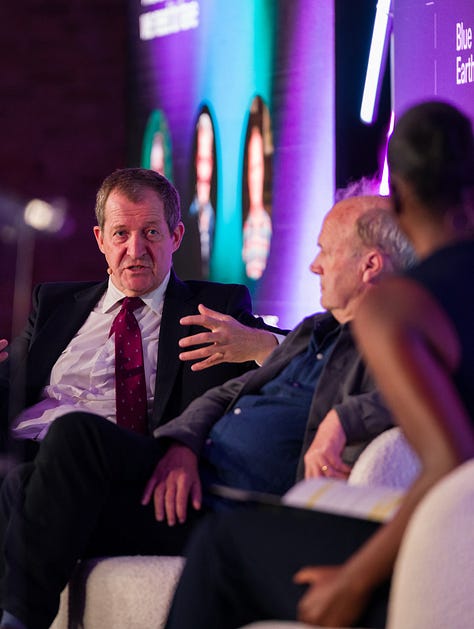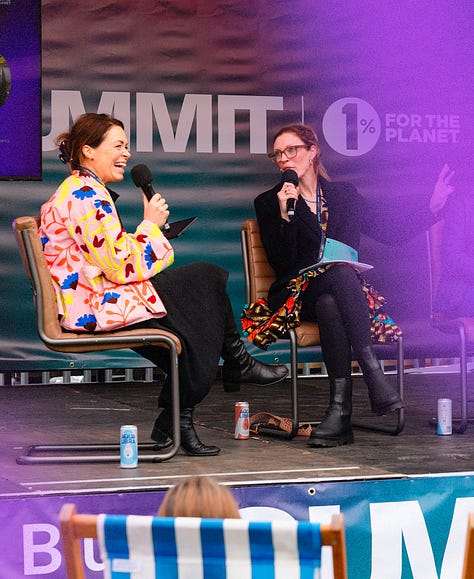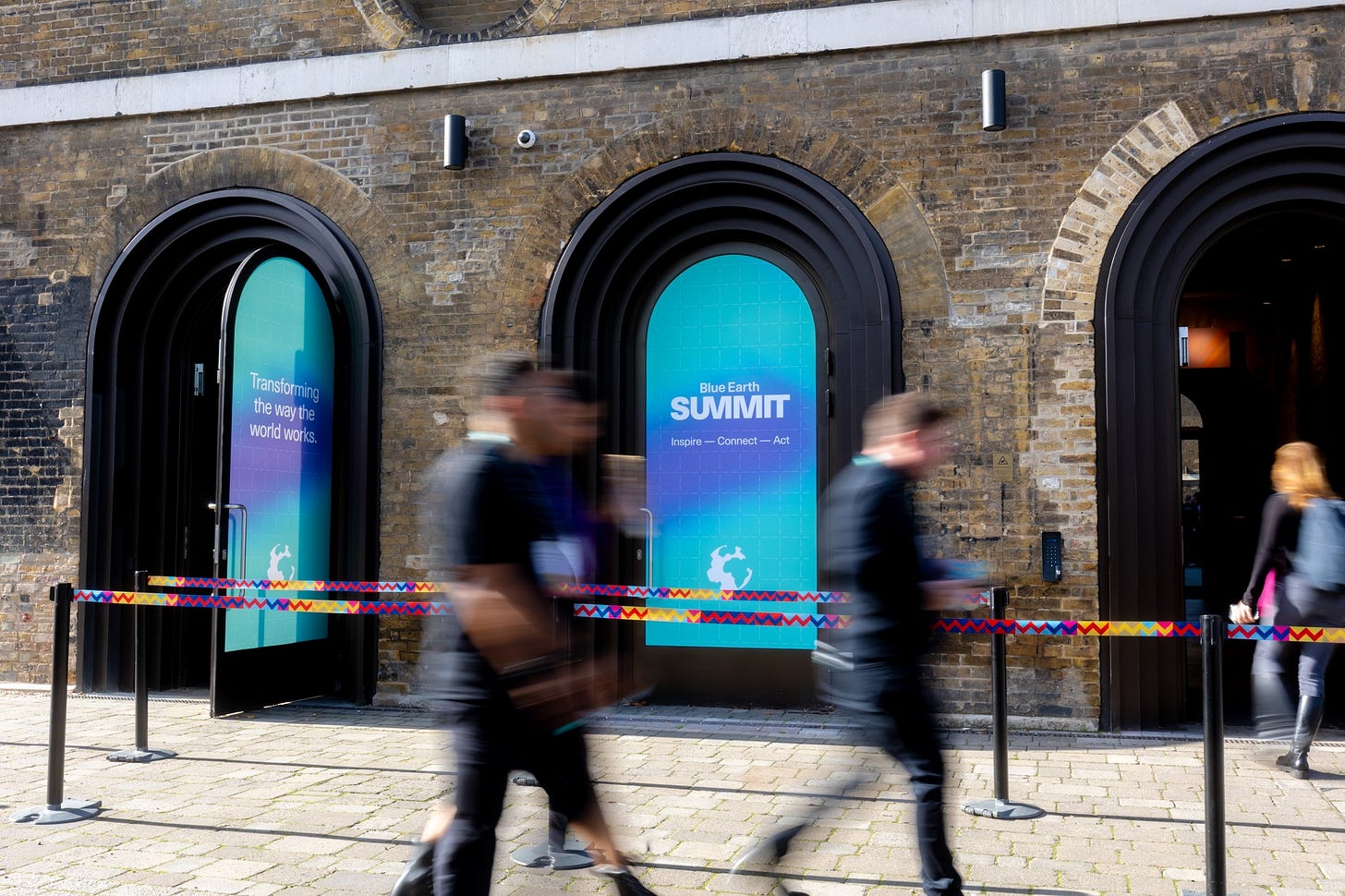Hope, Humanity and the Ocean’s Next Chapter: Notes from the Blue Earth Summit
From a site built for war to a movement built for renewal... why this week felt like a turning point for the ocean
Earlier this week, I wrote about something that’s difficult to say out loud. We’ve passed the first global tipping point. Coral reefs are now dying faster than they can recover.
It feels as though in 2025 we’ve entered a long stretch of bad news for the ocean. The collapse of the global plastics treaty, record marine heatwaves, mass bleaching events, each one a reminder that the systems we depend on are sliding out of balance.
That’s what made the Blue Earth Summit, held this week at Woolwich Works in East London, feel so important.
The summit isn’t an institutional conference or a closed-door policy meeting. It’s a gathering built by people, for people. A meeting of minds that brings together corporate leaders, scientists, athletes, inventors, entrepreneurs, and campaigners. Everyone there shares one belief: that we still have time to act, and that progress starts when unlikely allies sit in the same room.
For three days, the atmosphere buzzed with something rare: alignment. The sense that while governments argue and delay, ordinary people are already building the solutions.
The Woolwich Works has its own story of transformation. Once a royal munitions site and fireworks factory, it fuelled both conflict and celebration. This week, a place once built for war became the home of a new fight, the fight to protect and nurture the ocean.
No longer the sound of cannons being made, but ideas and plans being formed.
Those historic brick halls, which once manufactured destruction, became the backdrop for a new kind of creativity, one that looks outward, toward restoration and renewal.
Innovation with Purpose
I’m currenrly sat on the train home, my head swimming after so many conversations with people who are doing extraordinary things, too many to mention here. Every interaction was a reminder that innovation isn’t limited to labs or boardrooms. It’s happening in workshops, in classrooms, and out at sea.
There were people turning ocean waste into new materials, people restoring coral reefs, people running carbon literacy programmes and changing the way companies think about responsibility. Each of them tackling a different part of the same challenge: how to help the ocean recover.
I wish I could mention everyone. For now, I want to highlight a few conversations that really stayed with me, people who are pushing boundaries and approaching solutions in creative, unconventional ways.
Among them was Ben Medland, founder of Drift Energy, an Earthshot Prize nominee. When Ben talks about his work, there’s no sales pitch. Just unwavering belief. His team is building fleets of vessels that capture renewable power from the wind as they move, turning the ocean itself into a mobile, zero-carbon energy network. It’s one of those ideas that sounds futuristic until you hear him explain it. Then it feels inevitable. Technology working with nature, not against it.
Ant Rawlins, founder of Wildling, whose passion fills the room. He spoke about reconnecting people with wild spaces, not as a privilege, but as something every human deserves. His work bridges technology and emotion, using technology and storytelling to remind us that conservation doesn’t start with policy. It starts with memory, belonging, and love of place.
Dan Voyce from Scuba Network is driven, humble and quietly revolutionary. His team is uniting divers, scientists, and conservationists to transform every dive into usable data. It’s community-powered science. A living, breathing network of people turning their passion into measurable change for the ocean. What started off as an idea to point divers to the best dive sites around the world has now turned into a data set that can help map species, reefs and pollution.
Then, there was Charlie Pinder, a photographer and filmmaker with a rare ability to draw people in. He wasn’t there to sell anything, but to capture the humans behind the innovations.
We spoke about what drives people to do this work, and it stayed with me. Watching Charlie quietly disarm people with warmth and curiosity reminded me that conservation is, at its heart, a human effort. It’s humans speaking to humans, because it’s humans who make the decisions that shape our world.
Through his lens, Charlie was there to help people tell their stories honestly and emotionally. When people see others who care deeply, who keep going despite the odds, they realise they’re not alone. That recognition, more than anything, is what inspires others to act.
The Ocean’s Original Technology
Some of the ideas shared at Blue Earth sounded like science fiction, hydrogen-producing fleets, AI-guided mapping of the deep, biomimetic coral scaffolds. Yes, technology can help accelerate recovery, but I truly believe that the greatest technology we have is the ocean itself. A vast, self-regulating system that has kept Earth stable for millions of years. When we give it space, it knows how to heal.
Whales fertilise plankton blooms that draw down carbon. Coral reefs buffer coastlines and cradle life. Kelp forests rebuild in silence, pulling carbon from the air. Every one of them is a natural technology refined over millennia.





Where Hope Lives
The tools to heal the ocean already exist, in our labs, our laptops, our cameras, our communities, and within the sea itself. What we need now is alignment, urgency, and belief.
At Whale and Dolphin Conservation, that’s exactly what we’re working to build: uniting science, storytelling, and collaboration to give the ocean the space it needs to recover.
Huge praise to Emily, Emma, Chris, Hannah and Lisa, who were also there representing WDC, giving whales and dolphins a voice at a time they need it most. It’s a privilege to work alongside people so deeply committed to protecting life in the ocean.
As I left Woolwich, I felt something I haven’t in a while…
Hope.
Not naïve, but grounded in action.
Hope can be passive. It can sound like waiting for someone else to act, for something distant to change. However, sometimes, you meet people who make you see it differently. People whose work, energy, and vision remind you that progress isn’t a dream, it’s already happening, often quietly, in the hands of those willing to keep going.
I don’t often talk about hope, because it can feel like a fragile word in a world this broken, but after this week, I’ve seen what active hope looks like…
It looks a lot like people.
A year from now, I hope we’ll look back at this summit as the moment when things began to move faster in the right direction.
With gratitude and renewed purpose,
Luke
For those who are new here, welcome to Ocean Rising, and to my weekly podcast, Voice for the Blue.
This space exists to connect the dots between science, storytelling, and action. Each week, I share breaking ocean news, deep dives into the stories that matter, and occasional behind-the-scenes dispatches from the frontlines of ocean conservation.
You can subscribe for free to keep up with it all, or support this work so that those who can’t afford to pay can still read, listen, and stay informed.
Together, we’re building something rare. A global community giving the ocean a louder voice.





Thanks for sharing. A very different type of work than I’ve ever been involved with.
What was your favorite part of the conference?